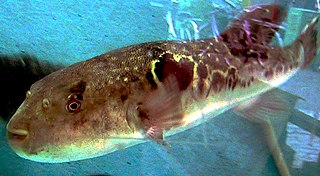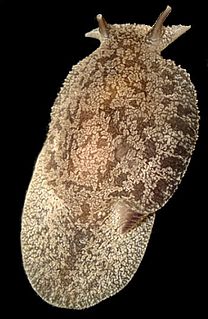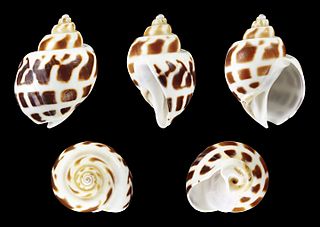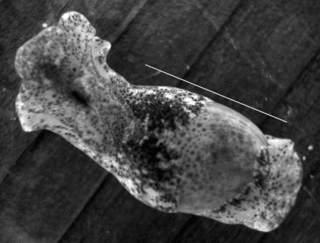
Tetrodotoxin (TTX) is a potent neurotoxin. Its name derives from Tetraodontiformes, an order that includes pufferfish, porcupinefish, ocean sunfish, and triggerfish; several of these species carry the toxin. Although tetrodotoxin was discovered in these fish and found in several other animals, it is actually produced by certain infecting or symbiotic bacteria like Pseudoalteromonas, Pseudomonas, and Vibrio as well as other species found in animals.

Takifugu is a genus of pufferfish, often better known by the Japanese name fugu. There are 25 species belonging to the genus Takifugu and most of these are native to salt and brackish waters of the northwest Pacific, but a few species are found in freshwater of Asia or more widely in the Indo-Pacific region. Their diet consists mostly of algae, molluscs, invertebrates and sometimes crustaceans. The fish defend themselves by inflating their bodies to several times normal size and by poisoning their predators. These defenses allow the fish to actively explore their environment without much fear of being attacked.

Astropecten polyacanthus, the sand sifting starfish or comb sea star, is a sea star of the family Astropectinidae. It is the most widespread species in the genus Astropecten, found throughout the Indo-Pacific region. The armspread is up to 20 cm (8 in). The specific epithet "polyacanthus" comes from the Latin meaning "many thorned".

Doto pita is a species of sea slug, a small nudibranch, a shell-less marine gastropod mollusc in the family Dotidae.

Surugatoxin (SGTX) is a type of venom found in the mid-gut digestive gland of the Japanese ivory mollusk Babyloniajaponica, a carnivorous gastropod. It functions as a ganglionic blocker of nicotinic acetylcholine receptors (nAChRs). The structurally and functionally related neosurugatoxin, also derived from Babylonia japonica, is an even more potent nAChR antagonist than SGTX.

Micromelo undatus, common name the miniature melo, is an uncommon species of small sea snail or bubble snail, a marine opisthobranch gastropod mollusk in the family Aplustridae.

Pleurobranchaea maculata, or the grey side-gilled slug, is a species of sea slug, specifically a side-gill slug or notaspidean. It is a marine gastropod mollusc in the family Pleurobranchaeidae.

Seashore wildlife habitats exist from the Tropics to the Arctic and Antarctic. Seashores and beaches provide varied habitats in different parts of the world, and even within the same beach. Phytoplankton is at the bottom of some food chains, while zooplankton and other organisms eat phytoplankton. Kelp is also autotrophic and at the bottom of many food chains. Coastal areas are stressed through rapid changes, for example due to tides.

Melo melo, common name the Indian volute or bailer shell, is a very large sea snail, a marine gastropod mollusc in the family Volutidae, the volutes.

Haminoea is a genus of medium-sized sea snails or bubble snails, marine opisthobranch gastropod molluscs in the family Haminoeidae, the haminoea bubble snails, part of the clade Cephalaspidea, the headshield slugs and bubble snails.

Conus tulipa, common name the tulip cone, is a species of sea snail, a marine gastropod mollusk in the family Conidae, the cone snails and their allies.

Turris babylonia, common name: the Babylon turrid or tower turrid, is a species of sea snail, a marine gastropod mollusk in the family Turridae, the turrids.

Babylonia areolata is a species of sea snail, a marine gastropod mollusc in the family Babyloniidae.

Zemiropsis papillaris, common name : the spotted babylon, is a species of sea snail, a marine gastropod mollusk in the family Babyloniidae.
Babylonia perforata is a species of sea snail, a marine gastropod mollusc in the family Babyloniidae. It has been named after Italian journalist Piero Angela.

Haminoea japonica, common name the Japanese bubble snail, is a species of sea snail or bubble snail, a marine opisthobranch gastropod mollusc in the family Haminoeidae, one of the families of bubble snails.
Otopleura nodicincta, common name the nodulose pyram, is a species of sea snail, a marine gastropod mollusk in the family Pyramidellidae, the pyrams and their allies.

Astropecten scoparius is a sea star in the family Astropectinidae. It is found in shallow water in the East China Sea and around the coasts of Japan. It is a grey starfish and each of its five arms has a narrow pale margin. It burrows in the muddy sediments on the seabed and feeds on molluscs.
Trapania japonica is a species of sea slug, a dorid nudibranch, a marine gastropod mollusc in the family Goniodorididae.

Diaulula boreopacifica is a species of sea slug, a dorid nudibranch, a shell-less marine gastropod mollusc in the family Discodorididae.



















